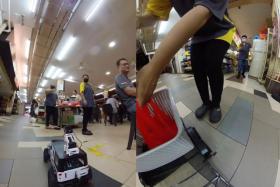IoT can help smart cities solve major traffic problems
Tech used to manage traffic issues must evolve as number of vehicles grows & population becomes denser
Governments around the world are leveraging advancements in technology to make cities smarter and more efficient, and Singapore is no exception.
One such technology used by cities is Smart Traffic Management - a solution that involves capturing, storing and processing vast amounts of data for cities to operate in a safer, more efficient environment.
Intelligent Transport Systems have played an important role in enhancing commuters' travel experiences here.
For example, Singapore was a pioneer in implementing congestion charges to manage traffic with the introduction of the Electronic Road Pricing (ERP) scheme in 1998.
The growing number of vehicles, denser population and changing technological landscape means the technology we use to manage traffic issues must evolve - starting with a potential satellite-based ERP system currently being field-tested.
The Internet of Things (IoT) will continue to play an important role in enabling Singapore to improve its urban mobility.
The rise of low-price sensors is enabling more effective ways to monitor and actively manage traffic using real-time data.
Developments in cloud computing have reduced the cost of storing the volume of information generated, while making the data more readily available for analysis. Big data technologies are transforming the nature of how cities operate.
One of the most significant challenges cities of the future face involve moving people and goods efficiently.
Data and analytics arm public officials with key insights into traffic congestion and incidents across the road network.
DATA
Using historical and real-time data, cities can identify congestion hotspots and use that information to address the most problematic areas and reap the greatest benefits.
Additionally, public officials can process incident data to determine the effect changing the way an intersection works has on safety.
Without new IoT infrastructure, congestion and hazardous conditions will worsen. And if our infrastructure does not adjust to population growth, they will continue to worsen.
The IoT, including a variety of sensing technologies and highway cameras, must be utilised if we want to adapt to changing traffic conditions.
IoT data can also be useful in learning traffic patterns, planning of infrastructure upgrades, improving daily traffic flow and reducing the negative impact accidents have on the health and safety of the public.
As the number of real-time video streams increases, as higher-resolution video boosts the raw data available with each stream, and as demands of analysing the data intensifies, so does the need for a robust mature cloud and infrastructure that allows for fast and secure data capture, management, storage, retrieval and analysis.
In the new data age, the need to store, organise and access unstructured data is critical, especially for applications such as traffic management and accident prevention.
The Data Age is not an era in the far-off future. Life critical data is permeating the foundation of our lives and our cities.
From ensuring our loved ones are safe on the road to helping build smarter infrastructure, data is revolutionising the human experience in ways we could not imagine a decade ago.
The writer is senior vice-president of global sales and sales operations at Seagate. This first appeared in The Business Times yesterday.
Get The New Paper on your phone with the free TNP app. Download from the Apple App Store or Google Play Store now


